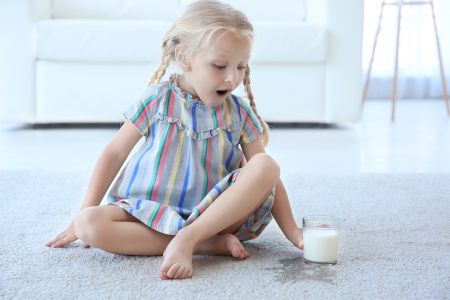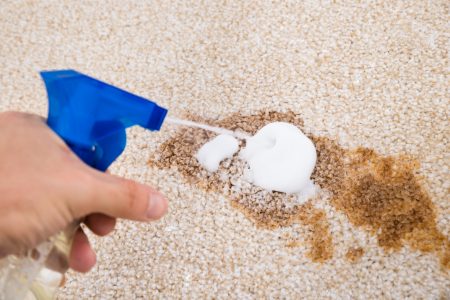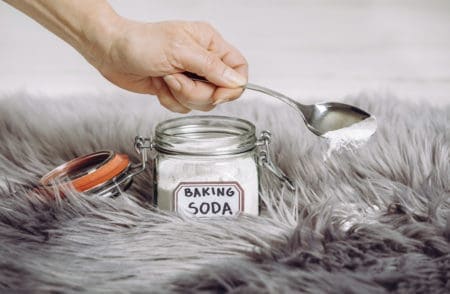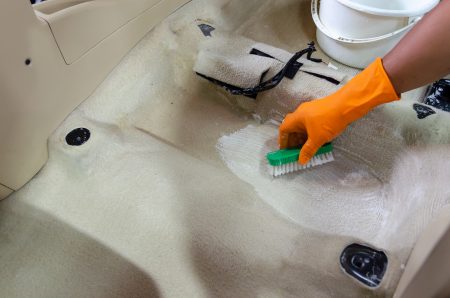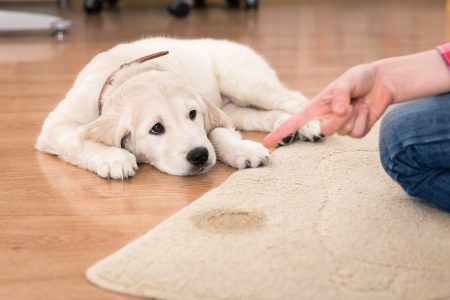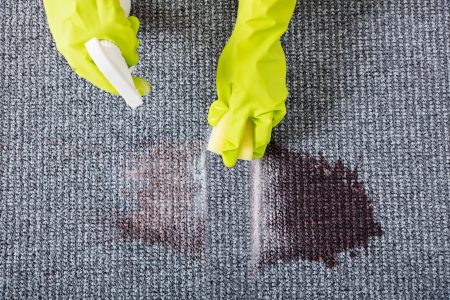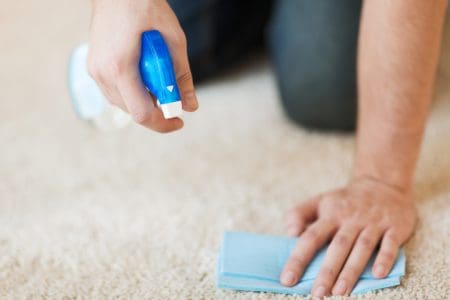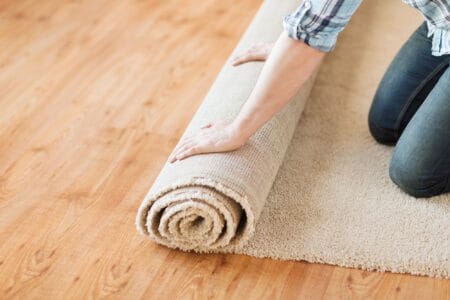The person who said there’s no use crying over spilled milk probably didn’t own a beautiful, expensive carpet. Milk might not look it, but it can be trouble in a carpeted home. If you leave milk spills and stains to stand, they could harden or, even worse, start to stink.
It’s tricky to know how to clean milk from your carpet properly. You can’t just wipe it up and move on.
We’ve got your back. Our step-by-step guide will walk you through how to clean milk from carpets.
Key Takeaways
- Milk spills on carpets are challenging to clean because milk contains protein that hardens when it dries.
- To clean fresh milk spills, use absorbent materials, cold water, and cleaning agents like vinegar or baking soda.
- For dried milk stains, rehydrate the protein with water and detergent, then gently scrub and blot the area.
- To remove milk smells, use baking soda, vinegar, or commercial cleaning agents to neutralize the odor.
Why Is Milk so Difficult to Clean?
If you haven’t noticed that milk mess is problematic, think of what happens when you leave a used cereal bowl to stand. It cakes, and cleaning it — even with the help of warm water and dish soap — takes some effort. The same thing will happen if it’s left to dry on your carpets. But why?
Chemistry is to blame. Milk is approximately three percent protein (1). And protein hardens when it dries out. Once dry, it’s challenging to rehydrate, which is why you need muscle to remove it.
Stains are also determined by how deep a mess can penetrate a surface. Glass, for example, won’t absorb milk so it won’t stain. However, your fabric carpet fiber will absorb liquid and trap spilled milk.
A dried milk stain can quickly go from a slight inconvenience to a full-scale war with your floor.
But your hardship doesn’t end there. If the sight of a milk stain is not enough to bother you, the germs inside one should. Milk is perishable, so bacteria will develop when milk is left to stand (2).
Watch Out: Switching to soy milk might not make a difference. It also contains protein and will dry out to the same effect as cow’s milk.
How to Clean Milk From Carpets
Now that you understand why milk is such a pain to clean, we will show you the best ways to remove it. There are various methods you can try, and most of them are easy, fast, and affordable.
Milk stains quickly, so you won’t have much time to fight it, even with a fresh spill. Don’t worry if your spill has already hardened, though. We’re going to walk you through each stage of staining so you can restore your carpets effectively.
For our DIY methods, you’ll need a few things. But there’s no need to run out and buy each of the following. Use the trick that suits what you already have.
- Absorbent paper towels, a sponge, or a soft cloth
- Cleaning agent of choice (i.e., vinegar, cornstarch, ammonia, detergent, baking soda, or sneaker crystals)
- Toothbrush
- Vacuum cleaner
Idea
Cleaning Fresh Milk Spills
- Time: Around 30 minutes
- Difficulty: Easy
1. Remove Excess Milk
Grab an absorbent paper towel, soft cloth or sponge, and soak up as much excess milk as possible.
2. Apply Cold Water
Once there’s no milk left to soak up, you can tackle the stain. Apply cold water to the spill or a cloth, and dab away at it. Don’t rub or scrub it; it will likely drive it deeper into your carpet.
3. Apply Cleaning Agent
Continue dabbing at the spill, refreshing your cloth in between. If water doesn’t seem to help, add your chosen cleaning agent to the spill.
With vinegar and ammonia, dilute a 1:1 solution in water and spray directly to the stain. Scrub in gently with an old toothbrush and leave for 5-10 minutes before rinsing well.
With cornstarch, baking soda, or sneaker crystals, sprinkle them over the stain and leave overnight. Rinse well.
Finally, with detergent, mix one tablespoon of detergent in a cup of water. Apply directly to the stain. Scrub in gently with an old toothbrush. Leave for 30 minutes, then rinse well.
The stain will be gone when your carpet dries.
Alternative Method
If you don’t want to blot at the mess, soak up whatever excess milk you can, and then apply cornstarch. This will soak up the milk for you, and once it dries, all you have to do is vacuum.
Some experts also suggest using coffee grounds. But keep in mind that this might leave a new stain.
Fact
Removing Hard Milk
If you have a milk stain that’s already dried, there’s still hope. It requires patience, but it’s just as easy and affordable as tackling a fresh spill.
- Time: 45 minutes
- Difficulty: Easy/Intermediate
1. Pre-Treat the Stain
You’ll have to rehydrate the protein before you stand a chance of removing the stain. To do this, soak the stain as best you can, and if you like, add detergent. You can also try applying a baking soda and vinegar solution as the fizz will agitate the proteins.
2. Add Water
Once you have left the treatment to absorb for a while, apply water to clean it. If it’s a stubborn stain, gently scrub it with a toothbrush, but don’t drive it deep into your floor.
3. Soak and Wipe
When you notice a difference, or if the stain is gone, use the same steps for a fresh spill. Apply water and blot the stain until it’s clean. Leave it to dry, and the milk should be gone from your carpet.
Top Tip
How to Remove Milk Smells
Sometimes, spilled milk will leave a nasty, sour smell. Thankfully, getting rid of it is extremely easy. But of course, it’s better to clean the stain entirely first. Here are five various methods for removing milk odors.
- Time: Five minutes (plus 12-hour waiting time)
- Difficulty: Easy
1. Baking Soda
It doesn’t matter if the stain is wet or dry. Adding some baking soda will soak up the smell. Leave it on the stain overnight, and vacuum it once it’s worked on the stain.
2. Vinegar Bowl
If you want as little effort as possible, use vinegar. You can apply vinegar directly to the stain, but you might not like the vinegar scent. An easier way is to fill a bowl with vinegar and leave it to stand next to the stain overnight.
3. Commercial Cleaning Agents
In place of baking soda, try powdered detergent. These typically come with pleasant scents that will override the milk smell. Look out for enzyme-based cleaners as they’ll have the greatest effect.
4. Sneaker Crystals
You can also try sneaker crystals designed exactly for odor removal. Apply them to the stain as you would the baking soda, leave them to stand overnight, and vacuum them up.
5. Ground Coffee
Remember that if it’s a wet stain, the coffee might stick or cause marks of its own. On a dry stain, ground coffee will absorb the odor of milk and can easily be vacuumed.
Quick Tip
FAQs
Cream of the Crop
Don’t write your carpets off just yet. Milk stains seem impossible to remove at first, but you can clean them almost effortlessly, whether they’re fresh or hard. You don’t even have to spend any money.
Milk contains protein, which is a pain to remove once it dries out. But by following our steps, you’ll be able to effectively tackle them without ruining your floors. Why don’t you try some of our tricks on other protein stains?
